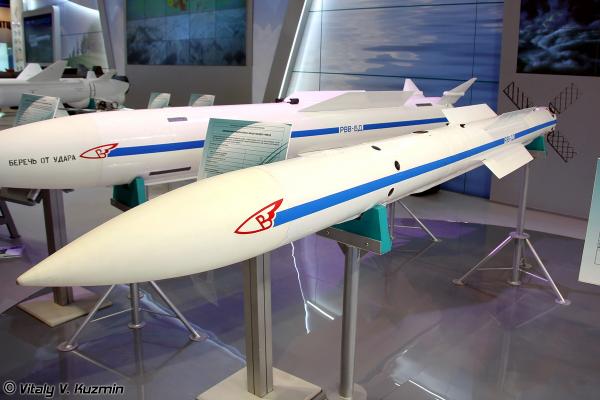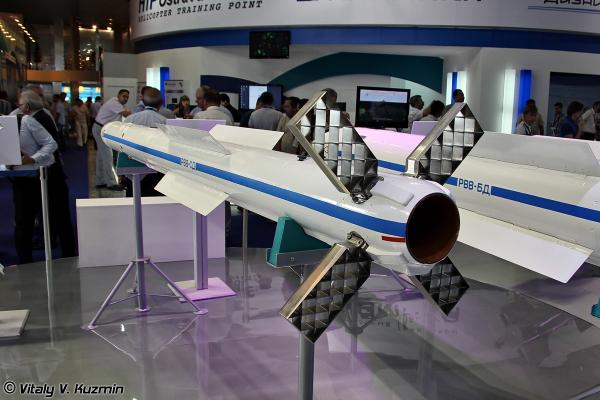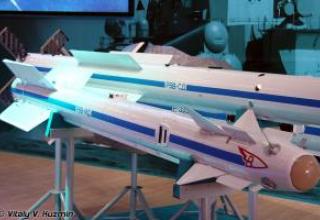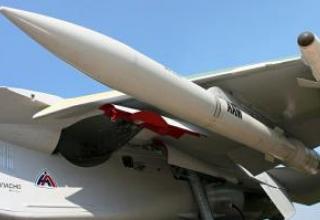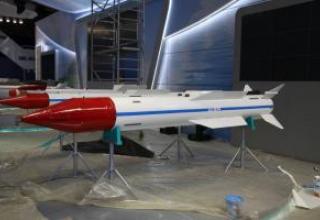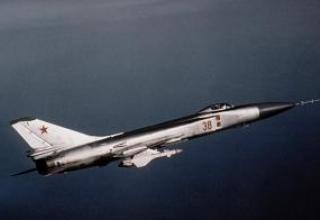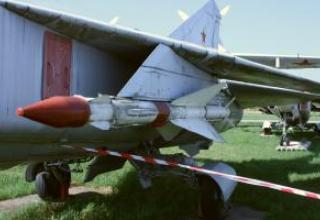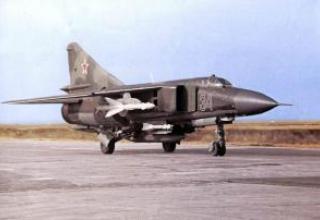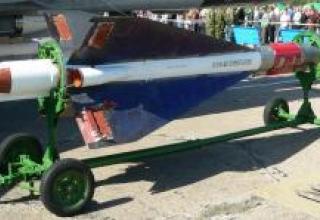Air-to-air" medium-range missile R-77-1 (item 170-1) is designed to engage air targets (fighters, attack aircraft, bombers, BTA aircraft, helicopters, cruise missiles) at any time of the day, from all angles, in the conditions of electronic counteraction, against the background of the earth and water surface, including multi-channel firing on the principle of "let's forget".
It is possible to adapt to the carriers of foreign production.
The main developer is I.I.Toropov State Engineering Design Bureau "Vympel". Export designation RVV-SD.
The "170-1" product is the result of a deep upgrade of the previous generation R-77(RVV-AE) missile and was developed primarily to fit on the Su-35S fighter (see photo) and Su-34 bomber (see photo). The missile is part of the fifth-generation T-50 fighter armament and can be mounted on its external sling units (see photo1, photo2). The upgraded MiG-31BM can carry up to four new R-77-1 missiles.
The task to develop "Product 170-1" was given by the Ministry of Defence in 2003. In December 2005, the first four samples for preliminary test launches were manufactured. After the production of 6 more products, the state joint testing phase was opened in 2006. In fact, however, no tests were conducted, as the Su-35S aircraft complex capable of using this product had not yet been created. At the end of 2010, the complex was ready for testing. The final launches carried out in the same year resulted in direct hits to the target, confirming all the set targets for this product class. Series production of the R-77-1 was launched at the Vympel MKB production facility.
The next stage in the development of the Vympel ICBM's range of medium-range missiles was Product 180, designed for armament of the fifth generation fighter - T-50. Product 180 is equipped with new combined active-passive radar homing heads developed by the Agat Research Institute, an advanced missile engine. Delivery of the 542U engine for the LKI product 180 was made in 2006. To fit inside the fuselage T-50 grating rudders were replaced by flat folding rudders.
A separate line of development of medium-range missiles, carried out by Vympel ICB The development of the 180-PD (extended range) product equipped with the 371 direct-flow jet engine.
Composition:
RVV-SD is a new generation missile equipped with advanced multichannel homing systems. The application of digital technologies, modern materials and components allowed to obtain higher tactical and technical characteristics as compared to the previous models. This applies to increasing the range, accuracy and probability of target acquisition, improving interference immunity, as well as ensuring the use of missiles in any climatic and weather conditions at any time of year and day.
Guidance system - inertial with radiocorrection and active radar homing. A modern monopulse Doppler active radar homing head (ARGSN) 9B-1103M created by Moscow Research Institute 'Agat' is installed on the RVV-SD rocket. The ARGSN 9B-1103M has significantly increased transmitter power and receiver sensitivity, updated software, improved noise immunity to artificial and natural interference. This allowed increasing the maximum front hemisphere launch range (FFR) up to 110 km and hitting targets maneuvering with an overload up to 12g.
The ARGSN 9B-1103M (see description) was demonstrated for the first time at the Farnborough International Airshow in 1998 and has been modernized several times since.
At the International Forum "Technologies in Mechanical Engineering 2014" Agat Research Institute presented new homing heads of 9B-1103M family, designed, among others, to equip products 170-1 and 180 :
- ARGSN 9B-1103M-200PS with additional passive channel (see description)
- ARGSN 9B-1103M-200PA with additional semi-active channel (see description).
According to the developers, the combination of two homing systems with different combat capabilities in one device provides increased effectiveness of the means of destruction equipped with this CNS.
The rocket propulsion system is a single-mode RDTT. Fuse - laser non-contact. Battle unit - rod, multi-cumulative.
Compared to RVV-AE, RVV-SD has improved aerodynamic characteristics through the use of an elongated nose radio-transparent fairing, streamlined tail end and recessed lattice steering wheel attachment units.
Suspension of the airborne missile RVV-SD on the aircraft - carrier is carried out with the help of aircraft catapult device AKU-170E. AKU-170E - piston type, drive type - pyrohydraulic. As an energy source, the EPK-28T-2 pyroelectron is used.
ACU-170E provides:
- reusable suspension and removal of the missile without further adjustments;
- forced ejection, holding it from turning on course and tilting until separation;
- application of the missile within 30 days without removal of the missile and additional checks and adjustments of the booster.
Characteristics:
| Launch range, km: - minimum at CSW - PPP maximum |
0.3 110 |
| Flight height of the targets, km: - minimum - maximum |
0.02 25 |
| Maximum overload of affected targets | 12 |
| Dimensions, mm: - length - case diameter - wingspan - steering wheel range |
3710 200 420 680 |
| Missile launch weight, kg | 190 |
| Weight of combat unit, kg | 22.5 |
| Available overload | 40 |
| Dimensions, mm: - length - width - altitude |
2400 120 215 |
| Separation parameters: - speed, m/s - pitch angle, ° - pitch speed, °/s - escort stroke, mm |
up to 7 between -2.0 and 0 between -10 and -70 ~100 |
| Power supply voltage, V | 27 +2,4 -3,0 |
| Weight, kg | 60±2 |
Testing:
29.07.2004 First tests of Arrow-2 system off the coast of California. The anti-missile successfully hit a target simulating a "Scud" missile at an altitude of 40 km.
26.08.2004 Arrow-2 system failed tests off the coast of California. The anti-missile failed to intercept a target fired from an aircraft simulating an advanced Scud-D missile. During the tests, the detection radar successfully detected and identified the target. Problems arose during the final phase of the interceptor flight, after the first stage separation.
On 02.12.2005, the missile defense battery deployed at Palmahim Air Base successfully intercepted a target simulating the operational-tactical missile "Shihab-3". In the tests, an upgraded version of the Arrow-2 block 3 anti-missile was used, which has enhanced tactical and technical data, including for actions against group targets.
11.02.2007 First night launch of the Arrow-2 anti-missile. Two geographically dispersed batteries of the Israeli ABM system were used in the tests. The interception was provided by a battery located at a greater distance from the launch site of a target launched from an Israeli Air Force F-15 fighter.
26.03.2007 Successful testing of the improved Arrow-2 rocket in conjunction with other systems of the complex. New interceptor has modernized control system and longer range.
16.04.2008 Successful launch of the new Arrow-2 block 3 missile modification on the target simulating Shahab-3 ballistic missile launched from F-15 fighter. During the tests in test mode for the first time the improved EL/M-2080S Super Green Pine detection radar was used.
07.04.2009 Successful test of the Arrow-2 block 4 missile. Ankor Cahol (Blue Sparrow) target launched by Israeli Air Force F-15 fighter from a distance of about 1000 km was intercepted over the Mediterranean Sea. The EL/M-2080 Green Pine radar and the American forward-based mobile radar (FBX-T) AN/TPY-2, deployed in the Negev in late 2008, took part in the test.
On 27.07.2010 the USA and Israel concluded an agreement on joint development of a new Arrow-3 missile system. According to the document, Israel will receive $100 million from the United States to work on this BMD system.
On 22.02.2011 the USA and Israel jointly tested the upgraded Arrow-2 anti-missile. The missile was launched on the California coast and was considered successful - the missile hit a ballistic target launched from a U.S. Navy ship. This test was the second one in which the full Arrow BMD system, including the EL/M-2080 Green Pine radar, took part.
29.07.2011 Successful first test of the Arrow-3 anti-missile system. The missile successfully hit the conventional enemy's ballistic target missile.
10.02.2012 Testing of the Arrow-2 block 4 anti-missile, as part of the complex. Detection and tracking of the target launched from an Israeli Air Force fighter was performed for the first time using the EL/M-2080S Super Green Pine radar. After the information was transmitted to the Citron Tree combat control system, an intercept team was formed and no actual missile launch was conducted.
25.02.2013 Israel Defense Ministry announced a successful flight test of the Arrow-3 complex over the Mediterranean Sea. The interceptor reached a flight altitude of 100km, the flight lasted 6 minutes.
03.09.2013 Israel Missile Defense Organization and the U.S. Missile Defense Agency (U.S.) announced the first flight test of a new target "Ankor Shahor" ("Black Sparrow"). The test was conducted at an Israeli test site in the Mediterranean Sea. The targets were launched at 9:15 a.m. The test was conducted at the Israeli test site in the Mediterranean Sea. The radar Super Green Pine of Arrow complex detected the target and provided escort, the information received was transmitted to the combat control system Citron Tree. According to the Israeli Defense Ministry, all elements of the missile defense system worked out as usual.
The Russian Defense Ministry said that the radar station of the Russian missile warning system, located in Armavir, detected the launch of two ballistic missiles from the Mediterranean Sea towards Syria. According to the Russian side, both objects fell into the sea.
09.09.2014 Testing of the Arrow-2 ABM system to intercept the Ankor Shahor target (see photo). Interception failed.
03.01.2014 According to the press-service of the Ministry of Defence, the second test of the Arrow-3 ABM system took place at the Palmakhim airbase. At 08:00, the Arrow-3 missile interceptor successfully entered the calculated flight path in the upper atmosphere, in accordance with the test plan. All systems worked out in the normal mode.
09.09.2014 The Israel Defense Ministry announced that the advanced Arrow-2 ABM system had been tested. The purpose of the tests, conducted with the assistance of the Pentagon, was to test the effectiveness of the new version of the system against future potential threats. Later on the Israeli media published information that the tests failed.
16.12.2014 Failed tests of the Arrow-3 anti-missile. The Israeli Defense Ministry reports that problems occurred during the launch of the missile.
10.12.2015 The Israel Defense Ministry reported the successful test of the Arrow-3 BMD system (see photo). The interceptor missile was launched at 8:10 local time and successfully intercepted the target outside the atmosphere. It was launched from the Palmachim military base at the Anchor Shahor target fired by an Air Force aircraft over the Mediterranean Sea.
Sources:
- http://vitalykuzmin.net/
- ОАО «Корпорация «Тактическое ракетное вооружение» http://www.ktrv.ru/
- Военно-технический сборник "Бастион" http://bastion-karpenko.ru/
- Missiles http://www.missiles.ru/
- https://readtiger.com/military.tomsk.ru/blog/index-39.html
- http://vympelmkb.com/products/prod01/
- http://nevskii-bastion.ru/9b-1103m-200pa/
- Газета «Вымпел» №11-(43) ноябрь 2010
- http://bmpd.livejournal.com/226568.html
- http://forums.eagle.ru/showthread.php?p=2304986
- РВВ-СД AIR TO AIR MISSILE. Рекламный листок JOINT STOCK COMPANY "STATE MACHINE BUILDING DESIGN BUREAU "VYMPEL BY NAME I.I. TOROPOV". Первая половина второго десятилетия ХХI века (материал предоставлен Гуровым С.В. (Россия, Город-Герой Тула).
